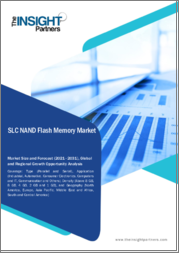
|
시장보고서
상품코드
1873718
DRAM/NAND 플래시의 자본 지출(2026년) : AI 주도 수정, 제한된 생산 능력DRAM/NAND Flash 2026 Capex: AI-Driven Revisions, Capacity Limited |
||||||
※ 본 상품은 영문 자료로 한글과 영문 목차에 불일치하는 내용이 있을 경우 영문을 우선합니다. 정확한 검토를 위해 영문 목차를 참고해주시기 바랍니다.
AI는 메모리 수요의 급증을 견인해 자본 지출의 재검토를 촉구하고 있습니다. 그러나 클린룸 공간의 제약과 단순한 생산능력 확대보다 선진기술로의 이행이 진행됨에 따라 미래의 비트 생산량의 성장이 억제될 전망입니다. 장치 공급업체는 낙관적인 관점을 보여주지만 메모리 기술의 과제는 높아지고 있습니다.
주요 하이라이트 :
- 당초 신중한 전망에도 불구하고 AI 수요가 증가함에 따라 메모리 자본 지출의 상향 조정이 진행되고 있습니다.
- DRAM 투자는 첨단 프로세스와 HBM 용량 확대가 우선하지만, 클린 룸 스페이스의 제약에 의해 비트 생산량의 성장은 억제됩니다.
- 낸드플래시의 설비투자는 하이브리드 본딩과 적층수 증가로 이동하고 있지만 공급업체간에 전략은 다릅니다.
- AI 스토리지와 클라우드 제공업체의 마이그레이션에 지원되는 NAND 플래시 수요는 구조적 부족을 보여주지만 제조업체는 당분간 확장에 신중한 자세를 유지하고 있습니다.
- 메모리 장치 공급업체는 AI 주도 수요에 낙관적이며 첨단 메모리의 복잡성과 높은 기술적 장애물 증가를 강조하고 있습니다.
- 업계 전반에 걸친 투자는 기존의 비트 용량 확장에서 공정 업그레이드 및 고부가가치 제품으로 전환하고 있으며, 미래의 비트 성장은 제한적일 것으로 예측됩니다.
목차
제1장 AI에 의한 수요 급증을 받아 메모리 업계는 2026년 설비투자 전망을 여전히 보수적으로 유지할 것으로 예상됩니다.
- 주요 DRAM 및 NAND 플래시 공급업체의 자본 지출액
제2장 DRAM 자본 지출 개요 : 1C 및 1-Gamma 공정으로의 전환과 HBM 관련 생산 능력 확대에 초점
- DRAM 업계의 연간 자본 지출액과 공급 비트수의 성장
- DRAM 공급업체의 팹 확장 계획
제3장 NAND 플래시에 대한 설비투자 - 상위층과 QLC를 우선하며 전반적인 수준은 보수적
- 낸드플래시 업계의 설비투자와 공급비트 성장
제4장 기기 프로바이더는 AI 주도 수요에 낙관적입니다. 메모리의 기술적 한계는 앞으로도 지속적으로 상승
제5장 투자가 주로 선진기술로 이동하는 가운데 DRAM과 NAND 플래시의 2026년 비트 성장은 제한될 것으로 전망됩니다.
KTHAI drives surging memory demand, prompting capex revisions. However, limited cleanroom space and a shift to advanced tech over raw capacity will constrain future bit output growth. Equipment vendors are optimistic, yet memory tech hurdles rise.
Key Highlights:
- Strong AI demand is leading to upward revisions in memory capital expenditure, despite initial conservative outlooks.
- DRAM investments prioritize advanced processes and HBM capacity expansion, though cleanroom space limitations constrain bit output growth.
- NAND Flash capex shifts towards hybrid bonding and higher layer counts, with varying strategies among suppliers.
- NAND Flash demand, fueled by AI storage and cloud provider shifts, represents a structural shortage; however, manufacturers remain cautious about immediate expansion.
- Memory equipment suppliers are optimistic about AI-driven demand, highlighting the increasing complexity and high technical hurdles in advanced memory.
- Overall industry investment is transitioning from traditional bit capacity expansion to process upgrades and high-value products, resulting in limited future bit growth.
Table of Contents
1. Memory Industry Still Maintains Conservative Capex Outlook for 2026 as AI Drives Demand Surge; There Is Potential for Upward Revisions
- Major DRAM and NAND Flash Suppliers' Respective Capex Figures
2. Overview of DRAM Capex: Focus Will Be on Migrations to 1C and 1-Gamma Processes and HBM-Related Capacity Expansions
- DRAM Industry's Annual Capex and Supply Bit Growth
- DRAM Suppliers' Fab Expansion Plans
3. Capex on NAND Flash - Overall Level Remains Conservative with Priority Set for Higher Layers and QLC
- NAND Flash Industry Capex and Supply Bit Growth
4. Equipment Providers Optimistic on AI-Driven Demand; Technical Threshold of Memory to Elevate Continuously in the Future
5. DRAM and NAND Flash Restricted in Bit Growth for 2026 as Investment Shifts to Mostly Advanced Technologies
샘플 요청 목록

















